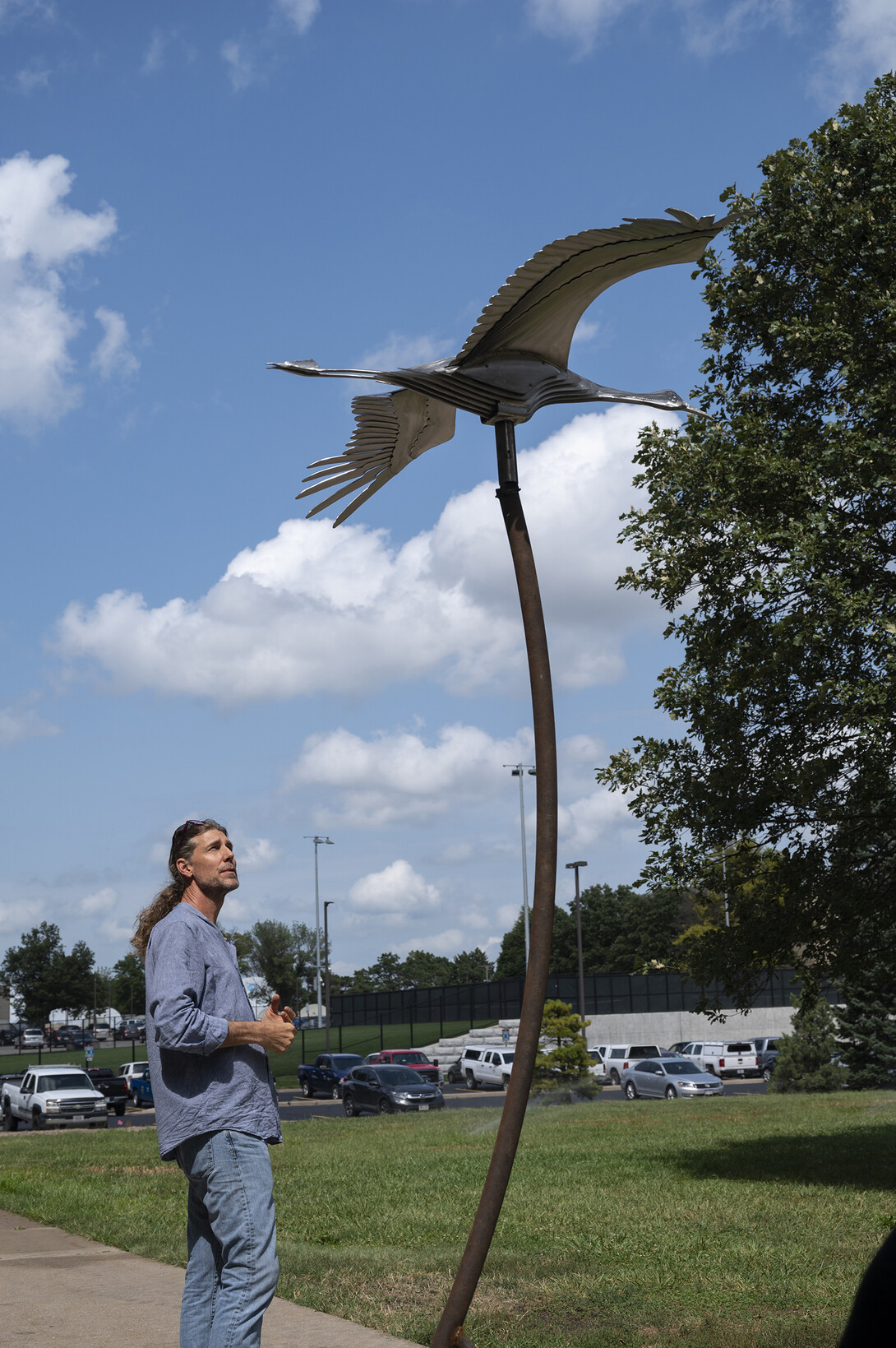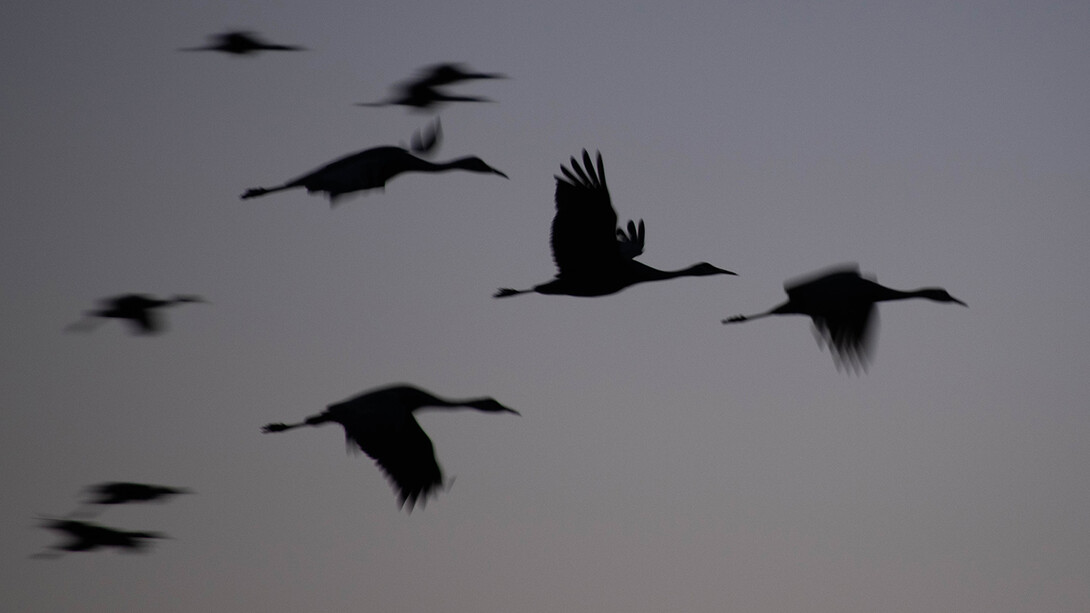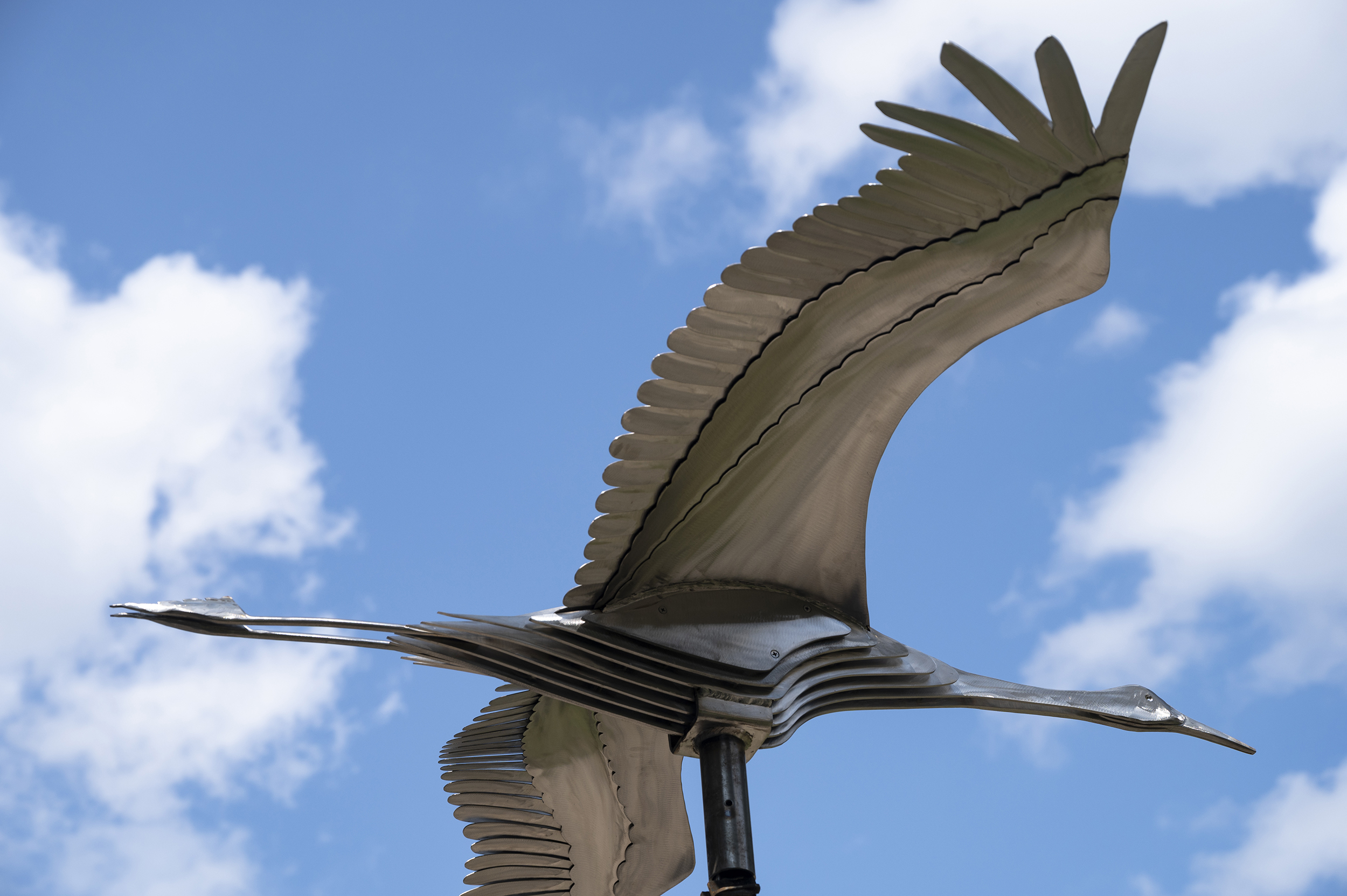
Denver-based metal sculptor Tiimo Mäng recently visited the University of Nebraska–Lincoln to receive input on his sculpture of a bird familiar to many Nebraskans.
When Mäng begins work on a piece, he said he starts by researching it, both from a historical and philosophical standpoint. He finds people who are relevant to the subject and listens to them. These are key parts of the process, he said, because he self-describes as form-blind. He will immerse himself in his work, step back and recognize something glaringly amiss in an early attempt. This happened with an early version of his latest work, a stainless steel sandhill crane. Its initial beak, Mäng was alarmed to discover, resembled the shape of a corn dog.
“I have a hard time translating what I see in form, a realistic form, into something in metal,” he said. “These birds are more of an interpretive version of a crane. I’ve stared at hundreds of pictures of birds, and these little details I struggle with.”
He eventually figured out the beak. But he wanted to put his crane sculpture in front of expert eyes, which is why he hauled it in a cargo van from Colorado to Nebraska’s School of Natural Resources on Aug. 30, where Mäng met with faculty, staff and students outside Hardin Hall.

Earlier in his research process, Mäng found himself immersed in “On Ancient Wings: The Sandhill Cranes of North America” by photographer and Platte Basin Timelapse project co-founder Michael Forsberg, so Mäng reached out. Forsberg had suggested that Mäng visit the International Crane Foundation in Baraboo, Wisconsin, to meet with its co-founder, crane expert and “On Ancient Wings” forward writer George Archibald. Mäng put the bird in his van and brought it to Wisconsin earlier this year, where Archibald’s observations led to several major modifications of the sculpture. Produced through a series of hand and machine cuts, the steel crane has now been through three metamorphoses. After the third, Mäng asked if he could bring the piece to the School of Natural Resources, where the Platte Basin Timelapse offices are located.
“I reached out to Mike and said, ‘Hey, do you mind if I bring one of my birds out that was on a sculpture that I’ve done some recent modifications to see if you think it feels right or not?’” Mäng said.
Mang and some Platte Basin Timelapse staffers carried the sculpture from his van to the north Hardin Hall lawn and set it up on a temporary tripod. The sculpture was intended to represent a crane as it took flight.
“That’s what I see,” said John Carroll, School of Natural Resources director, as he studied it.
The crane has deep meaning to Mäng, who began sculpting with his remodeling business tools over a decade ago after experiencing a debilitating skiing accident that coincided with his father’s declining health. Building furniture and, eventually, wildlife from wood and metal helped pull him out of a deep depression, he said. Seeing how people react to his interpretive, yet lifelike, sculptures helped, too. It’s not often, he said, that you can get close to a bird with a seven-foot wingspan.
“Part of me feels like our own human spirit wants to be free, and it wants to fly,” Mäng said. “And I think for me, these birds help do that. They draw us up and call on part of our innate being that wants to be free and fly and soar.”
Having said that, Mäng wanted to know what the experts thought of this specific bird. To make the crane, Mäng both hand cut and machine cut steel to achieve an interpretive version of the bird in flight. But he still wanted the layers of feathers to look right, the talons to be proportional.

“I think if I saw a silhouette of your sculpture, it looks like the silhouettes of pictures I’ve taken out there,” said Brooke Talbott, Platte Basin Timelapse producer.
Said Forsberg: “One thing I’ve noticed with cranes over the years is that they’re just like people. We have two arms and two legs and we stand upright and that’s about where it stops. If you are out on the Platte in the springtime and you look at a thousand birds out there on a roost or flying overhead, they’re all different. Some are stockier and some are longer. Some have longer legs and shorter beaks and some have longer beaks and shorter legs.”
This wasn’t the first time that a sculptor had sought out Forsberg’s opinion on a piece. Nebraska native Cliff Hollestelle, who specializes in ultra-realistic wood and bronze wildlife sculptures, completed a bronze sculpture inspired by one of Forsberg’s photographs, titled “Joy.” It features a sandhill crane in the throes of its courtship dance. There have been a few other artists who have reached out, though this was the first time that anyone placed a work in progress on the Hardin Hall lawn and asked Forsberg and a collection of wildlife photography and wildlife biology experts to shoot him straight.
“Anything that’s creative, it’s always good to come out and ask somebody else what they think,” Forsberg said. “And it could be somebody who knows as much as you or it could be somebody who knows nothing. Both are valuable.”
Share
News Release Contact(s)
Related Links
Tags
High Resolution Photos

HIGH RESOLUTION PHOTOS

HIGH RESOLUTION PHOTOS








